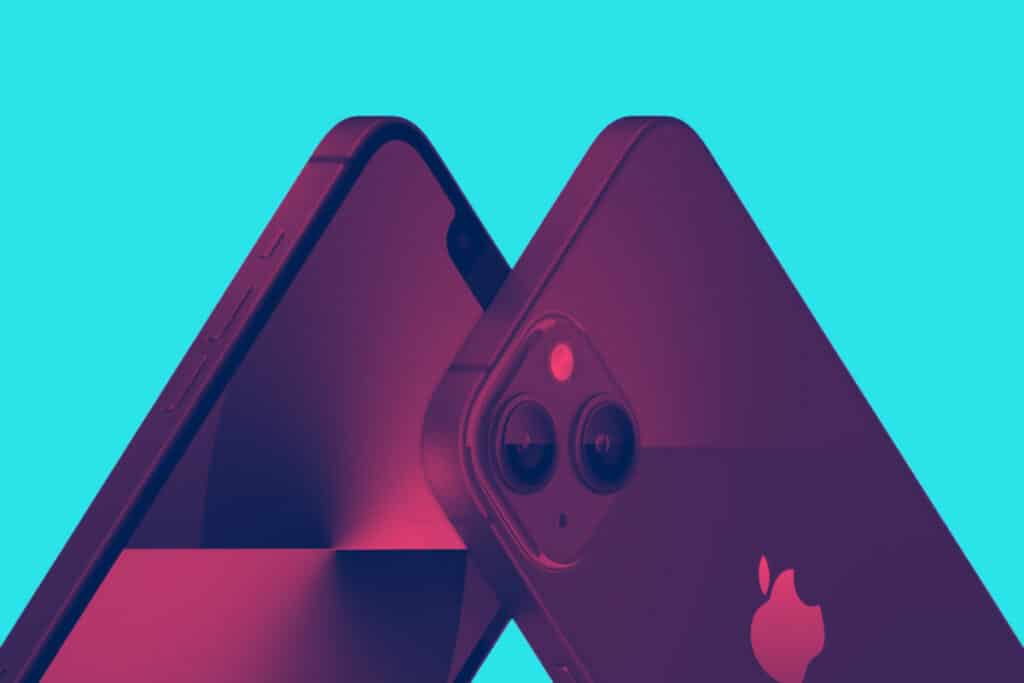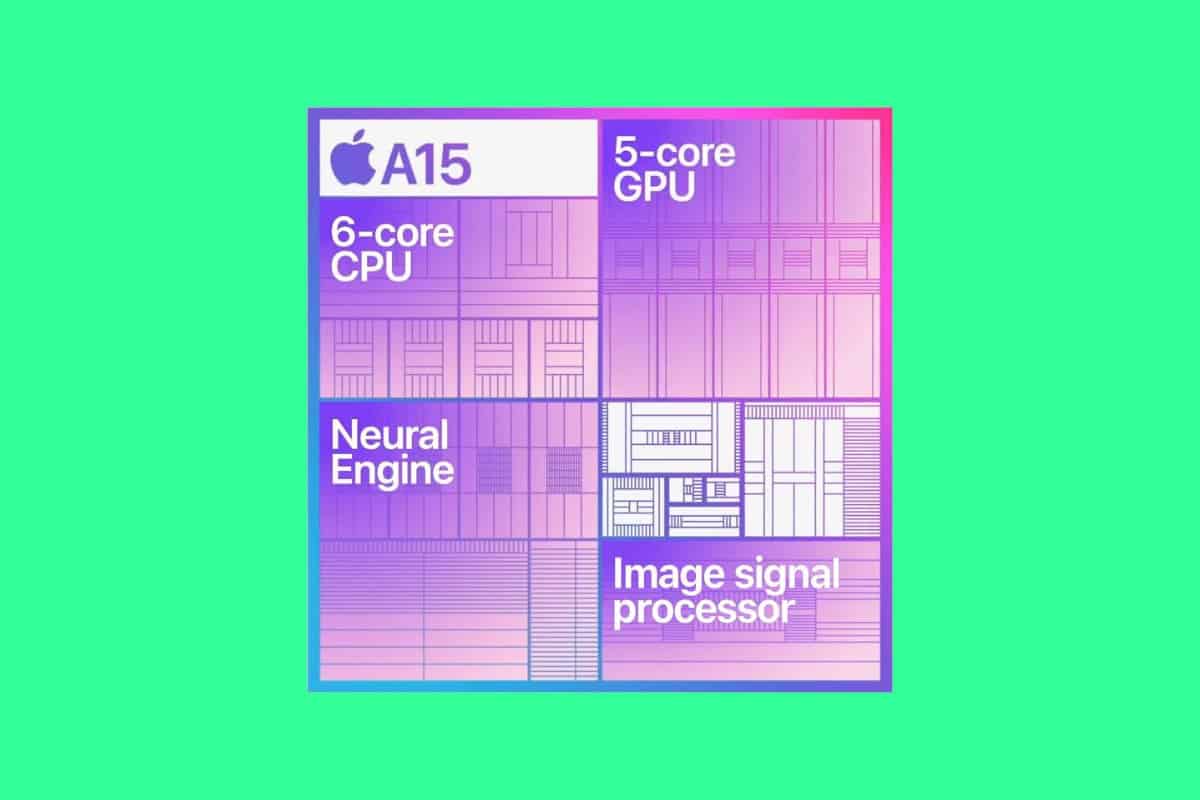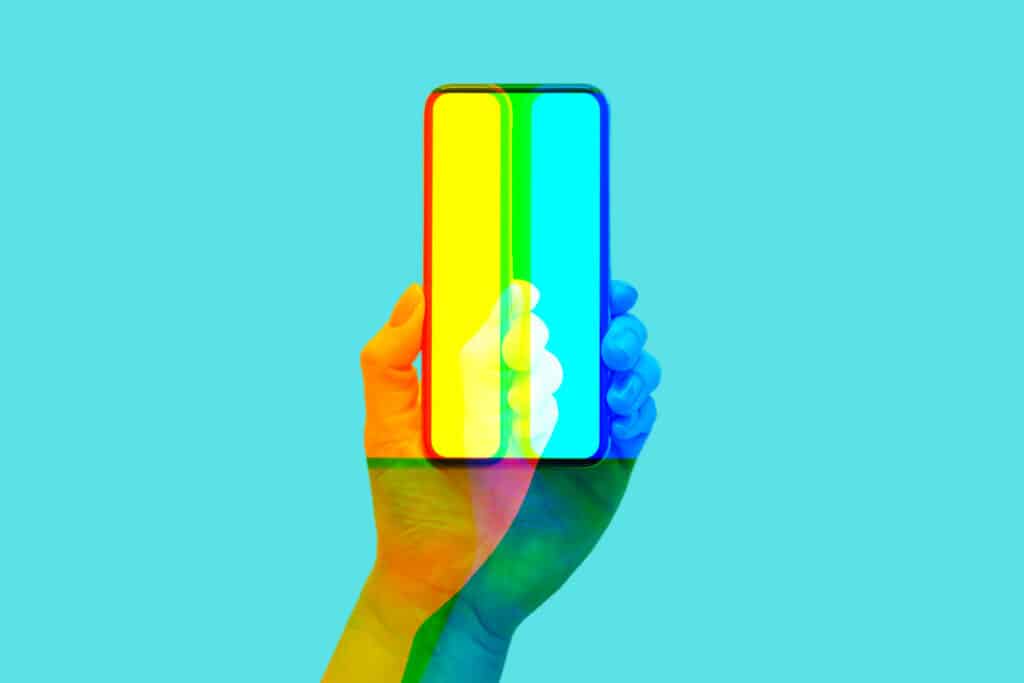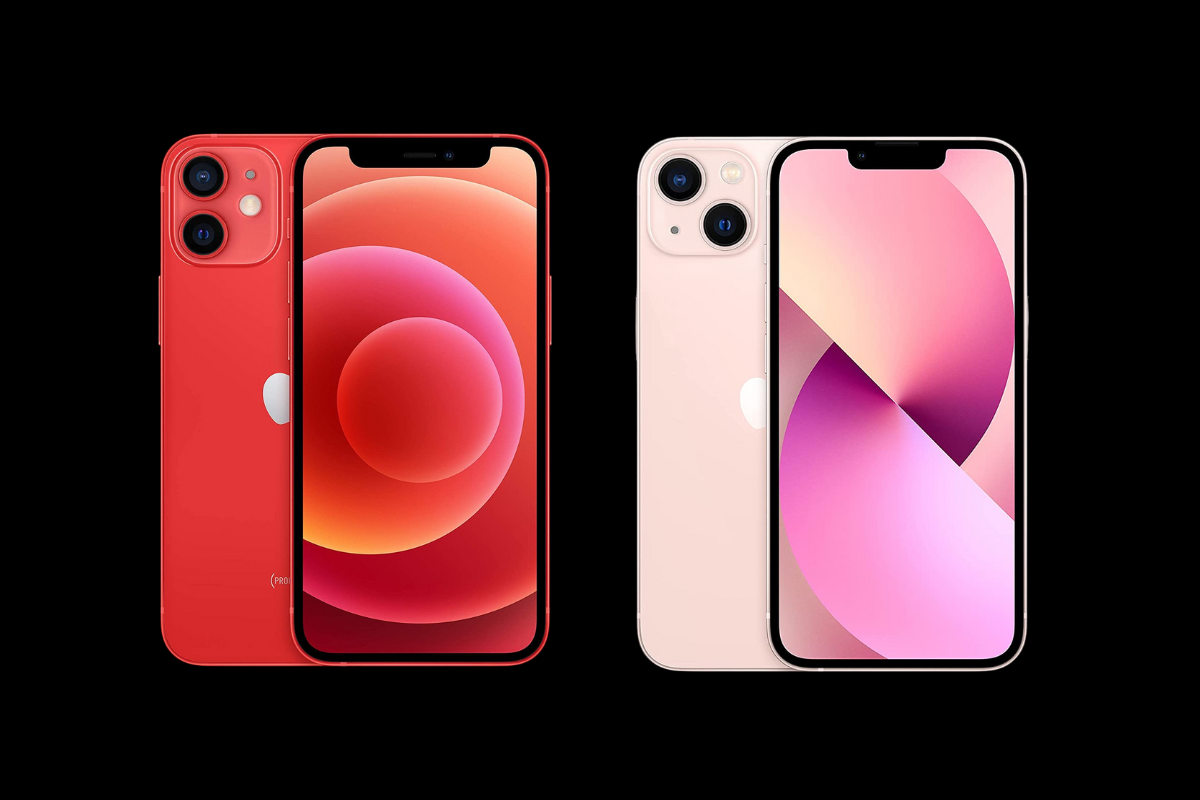How does Apple’s iPhone 13 compare against the iPhone 12? It is worth upgrading from the iPhone 12? Or should you hold onto your phone for another year and wait for the iPhone 14?
TL;DR: iPhone 12 vs. iPhone 13 – The Verdict
This iPhone 13 is a significant update over the iPhone 12. Most importantly, it fixed the iPhone 12’s terrible battery life bringing the 13 series back in line with the iPhone 11 series.
You get faster performance, the camera is been improved noticeably, and the display is brighter which improves usability in all environments.
Add in the fact that the iPhone 13 is now very cheap to buy, that it’ll get updates for years to come, and the decision is easy – get the iPhone 13.
Design & Display:
- Both rock a sleek aluminum and glass design, but the iPhone 13 comes in some snazzy new colors like Pink and Blue.
- They share the same 6.1″ Super Retina XDR OLED display, but the iPhone 13 cranks up the brightness to 800 nits (vs 625 nits on the 12).
Cameras:
- Dual 12MP shooters on both, but the iPhone 13’s cameras let in more light for better low-light performance.
- iPhone 13 brings Photographic Styles and Cinematic mode for video, upping your creative game.
Performance:
- A15 Bionic chip in the iPhone 13 is a powerhouse, beating the already speedy A14 in the iPhone 12.
- More GPU cores and a beefier Neural Engine give the iPhone 13 the edge for gaming and machine learning tasks.
Battery Life:
- iPhone 13 gets a nice bump in battery life, with up to 19 hours of video playback (vs 17 hours on the 12).
- Both support MagSafe wireless charging for convenient top-ups.
Conclusion:
The iPhone 13 offers tangible improvements over the iPhone 12 in key areas like battery life, display brightness, camera capabilities, storage options, and overall performance.
Both models are now discontinued, but the iPhone 13 is still a viable buy in 2024 and you could save 40% buy getting one refurbished.
iPhone 12 vs iPhone 13: A Comparative Analysis

Battery Life: A Game Changer
The iPhone 12, when it was launched, was celebrated for many of its features, from its sleek design to its powerful A14 Bionic chip. However, even the best devices have their Achilles’ heel, and for the iPhone 12, it was its battery life, particularly when connected to 5G networks.
5G: A Double-Edged Sword
5G, the fifth generation of mobile networks, promises faster download and upload speeds, more reliable connections, and the ability to connect more devices at once. While these advantages make 5G a significant leap from 4G, they come at a cost: increased battery consumption. The iPhone 12, being one of Apple’s first devices to support 5G, was especially susceptible to this.
Why 5G Drains Battery Faster
- Constant Searching: In areas with inconsistent 5G coverage, the iPhone 12 often had to keep searching for a stable 5G signal. This constant search mode consumed more power.
- 5G Modem Power Consumption: 5G modems, especially the earlier ones, are known to be more power-hungry compared to their 4G counterparts. This meant that even when the iPhone 12 had a stable 5G connection, it was using more battery than it would on a 4G network.
- Data Intensity: 5G’s faster speeds encourage users to consume more data-intensive content, like 4K videos or high-resolution online gaming. Such activities naturally deplete battery life quicker than less demanding tasks.
Real-World Implications
Many iPhone 12 users reported noticing a significant difference in battery longevity when using 5G compared to when they were on 4G. This was especially true in areas where 5G was still being rolled out and wasn’t fully optimized. The result was a device that, while groundbreaking in many ways, required more frequent charging for those keen on using 5G to its fullest potential.
Verdict?
- iPhone 12’s Shortcoming: The iPhone 12, despite its strengths, had a notable weakness in battery life, especially with 5G usage.
- iPhone 13’s Advantage: Apple addressed this in the iPhone 13 by integrating larger batteries across all models. The result? The iPhone 13 Mini lasts a full 90 minutes longer than the iPhone 12 Mini. If battery longevity is crucial for you, the iPhone 13 is a clear winner.
Display Brilliance
Both the iPhone 12 and iPhone 13 are equipped with OLED panels, a technology known for its deep blacks, high contrast ratios, and vibrant colors. However, the iPhone 13 has taken a significant leap forward in terms of brightness, boasting an increase of about 28% compared to its predecessor.
Why Screen Brightness Matters:
- Enhanced Outdoor Visibility: A brighter screen means that the display remains clear and easily readable even under direct sunlight. This is especially beneficial for those who often use their phones outdoors, ensuring that they don’t have to squint or shade their screens to see content.
- Improved Media Consumption: Whether you’re watching videos, browsing photos, or playing games, a brighter screen can enhance the overall experience. Colors appear more vibrant, and details stand out, making for a more immersive experience.
- Adaptive Comfort: With increased brightness capacity, the iPhone 13 can better adjust to various lighting conditions. This means whether you’re in a dimly lit room or a bright outdoor setting, the display can adapt to offer the most comfortable viewing experience.
- Battery Efficiency: While it might seem counterintuitive, efficient brightness management can actually aid in battery conservation. With advanced adaptive brightness technologies, the iPhone 13 can adjust its brightness levels more effectively to suit the environment, ensuring that it doesn’t use more power than necessary.
In conclusion, while both the iPhone 12 and iPhone 13 feature advanced OLED panels, the significant boost in brightness on the iPhone 13 offers tangible benefits. From improved outdoor usability to a richer media consumption experience, the enhanced brightness ensures that users get the most out of their device in various settings.
Verdict?
- Brighter and Better: While both the iPhone 12 and iPhone 13 boast OLED panels, the iPhone 13’s display offers about 28% more brightness. This enhancement ensures a clearer and more vibrant viewing experience.
- ProMotion Technology: Exclusive to the iPhone 13 Pro and Pro Max, ProMotion adjusts the refresh rate dynamically up to 120Hz. This means smoother animations and more responsive touch feedback compared to the iPhone 12’s 60Hz.
Camera: Subtle Yet Significant Upgrades

Apple’s commitment to pushing the boundaries of smartphone photography is evident when comparing the iPhone 12 and iPhone 13. Here’s a deeper dive into the camera enhancements of the iPhone 13:
The Power of a Larger Sensor:
- Enhanced Light Capture: The iPhone 13 is equipped with the largest sensor ever seen in a dual-lens camera setup. This allows it to capture 47% more light than the iPhone 12. More light means clearer, sharper images, especially in challenging lighting conditions.
- Superior Low-Light Photography: With the ability to absorb more light, the iPhone 13 excels in low-light scenarios. Whether it’s a dimly lit room or a sunset landscape, photos come out brighter and more detailed.
- Richer Image Quality: A larger sensor not only improves brightness but also enhances the overall richness and depth of photos. Expect more vibrant colors and better contrast ratios.
Advanced Features for the Avid Photographer:
- Sensor-Shift Optical Image Stabilization: Previously reserved for the Pro models, this feature is now available in the base iPhone 13 model. It stabilizes the sensor instead of the lens, ensuring clearer shots even when there’s movement or hand shake.
- Revamped Ultra-Wide Lens: The iPhone 13’s ultra-wide lens has undergone significant improvements, particularly in its low-light performance. This means wider shots without compromising on quality, capturing more of the scene without loss of detail.
Verdict?
In essence, while the iPhone 12 already had a commendable camera system, the iPhone 13 takes it a step further. For those passionate about photography, or even casual users wanting to capture life’s moments in the best quality, the iPhone 13‘s camera enhancements are a game-changer.
- Larger Sensor: The iPhone 13 boasts the largest sensor ever in a dual-lens camera, allowing 47% more light than the iPhone 12. This means better low-light photos and richer image quality.
- Improved Features: The base iPhone 13 model now includes sensor-shift optical image stabilization and an enhanced ultra-wide lens. For photography enthusiasts, these tweaks can make a world of difference.
- Pro Camera Advancements: The iPhone 13 Pro models further push the boundaries with even larger sensors, a 3x optical zoom (compared to the iPhone 12 Pro’s 2.5x), and the introduction of ProRes technology for professional-grade video recording.
Storage: More Room for Creativity
Apple’s iPhone storage options have evolved over the years, catering to the growing needs of users. With high-resolution photos, 4K videos, and expansive app libraries, having ample storage is more crucial than ever.
Let’s delve into the storage capacities available for the iPhone 12 and iPhone 13:
iPhone 12 Storage Options:
- 64GB: Suitable for light users who primarily use cloud services and stream most of their content.
- 128GB: A middle-ground option, ideal for those who store a moderate amount of photos, videos, and apps.
- 256GB: For heavy users who have extensive photo libraries, download movies, or use a wide range of apps and games.
iPhone 13 Storage Options:
- 128GB: The base storage option has been doubled from the iPhone 12, providing more space for users right from the start.
- 256GB: Maintaining its position as a choice for heavy users, especially those keen on photography and videography.
- 512GB: A significant step up, perfect for professionals or enthusiasts who shoot a lot of high-resolution videos or want to keep vast amounts of data on their device.
- 1TB (Available on Pro models): A first for iPhones, this massive storage capacity caters to professionals who use features like ProRes video recording or those who want the absolute maximum storage space without any compromises.
Why Storage Matters:
- Future-Proofing: Opting for a higher storage variant ensures your device remains capable of handling your storage needs for years to come, even as apps and media files grow in size.
- Performance: iPhones tend to perform better when they have more free storage. Overfilling an iPhone can lead to slower app launches and reduced overall responsiveness.
- Resale Value: Devices with higher storage capacities often have better resale values, making them a good investment for those who upgrade their phones regularly.
In conclusion, while both the iPhone 12 and iPhone 13 offer a range of storage options, the iPhone 13 takes a leap forward by starting with a larger base storage and introducing the colossal 1TB option for its Pro models. Choosing the right storage capacity depends on individual needs, but with the iPhone 13, Apple ensures there’s an option for everyone.
Performance: Apple’s A14 vs A15 CPU

While both the A14 (iPhone 12) and A15 (iPhone 13) are powerhouse chips, the A15 offers around 20% more performance. Combined with its enhanced efficiency and the iPhone 13‘s larger battery, users experience a noticeable boost in responsiveness and battery longevity.
Let’s delve deeper into what sets these two chips apart and why it matters:
Performance Boost:
- A14 Bionic (iPhone 12): This chip, built on a 5nm process, was a significant leap from its predecessor, offering faster speeds and improved energy efficiency. It set a new benchmark for mobile processing at its launch.
- A15 Bionic (iPhone 13): While still utilizing the 5nm process, the A15 takes things a step further. It offers approximately 20% increased performance over the A14. This enhancement translates to smoother multitasking, quicker app launches, and an overall snappier user experience.
Enhanced Efficiency:
The A15 isn’t just about raw power; it’s also designed for optimal efficiency. This means the iPhone 13 can handle intensive tasks or extended use without draining the battery rapidly.
Graphics Prowess:
The GPU in the A15 Bionic has also received enhancements, making it more capable of handling graphic-intensive tasks like gaming, augmented reality, and video editing with greater ease.
Complementing the iPhone 13’s Battery:
One of the standout features of the iPhone 13 is its larger battery. When combined with the efficiency of the A15 chip, users get extended battery life, reducing the need for mid-day charges. This synergy ensures that the iPhone 13 not only performs better but also lasts longer on a single charge.
Neural Engine and AI:
Both the A14 and A15 chips come equipped with Apple’s Neural Engine, designed for advanced machine learning tasks. However, the A15’s Neural Engine is even more refined, allowing for faster on-device intelligence, which powers features like Live Text and Photographic Styles.
Why This Difference Matters
In the ever-evolving world of tech, the demand for faster and more efficient devices is constant. While the A14 already provided a stellar experience, the A15 ensures that the iPhone 13 remains ahead of the curve, offering users a device that’s not just faster on paper, but noticeably more responsive and enduring in real-world usage.
In conclusion, while both the iPhone 12’s A14 and iPhone 13‘s A15 are top-tier chips, the enhancements in the A15 make the iPhone 13 a compelling upgrade, especially for those who demand the best in performance and efficiency.
Should You Upgrade to the iPhone 13?

While the iPhone 12 is undeniably a strong contender, the iPhone 13‘s enhancements in battery life, display technology, camera capabilities, and performance make it a superior choice. And in 2023, this point still stands: the iPhone 13 – with its new, lower price point – offers some of the best value for money on the phone market right now.
iPhone 13 Resource Hub 📚
Here’s some of our most helpful content related to the iPhone 13. If you’re looking to buy one, the in-depth guides and reviews below should help:


